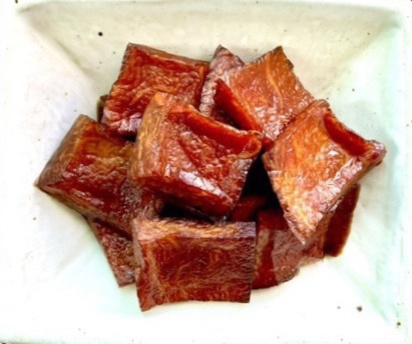Crispy Watermelon Rind Pickles
How to Make Deliciously Crunchy Watermelon Rind Pickles (Discarded Parts Transformed!)

Watermelon is the ultimate summer fruit, perfect for cooling down and quenching thirst. However, a significant amount of rind is often left behind, filling up trash bags. I’ve previously made pickles from melon rinds, and since watermelon is a type of melon, I thought I’d try it with watermelon rinds too! By collecting the white part of the rind and pouring a well-balanced mixture of soy sauce, sugar, and vinegar over it, you can create surprisingly delicious and crunchy pickles. The texture is wonderfully crisp, similar to pickled daikon or gourd pickles, but with a unique chewiness that’s incredibly satisfying. This recipe is a fantastic way to reduce food waste while making a delightful condiment. You might even find yourself buying an extra watermelon just to make more pickles!
Main Ingredients- 900g prepared watermelon rind
- 350ml sugar (for salting the rind)
All-Purpose Pickle Brine Ingredients- 900ml liquid from salted watermelon rind
- 450ml brewed soy sauce
- 250ml vinegar
- 3 Tbsp plum extract (maesilcheong)
- 1 Tbsp lemon juice
- 150ml soju (or other neutral spirit)
- 6-7 cloves garlic, whole
- 3 Korean chili peppers (cheongyang)
- 1 dried shiitake mushroom
- 1 knob ginger
- 1/4 stalk green onion (white part preferred)
- 900ml liquid from salted watermelon rind
- 450ml brewed soy sauce
- 250ml vinegar
- 3 Tbsp plum extract (maesilcheong)
- 1 Tbsp lemon juice
- 150ml soju (or other neutral spirit)
- 6-7 cloves garlic, whole
- 3 Korean chili peppers (cheongyang)
- 1 dried shiitake mushroom
- 1 knob ginger
- 1/4 stalk green onion (white part preferred)
Cooking Instructions
Step 1
First, prepare the watermelon rind. Cut the watermelon into manageable pieces. Carefully trim away all the red flesh from the rind. Then, shave off the tough, dark green outer skin to about 2-3mm thickness, leaving only the white inner rind. Collect all the prepared white rind.

Step 2
Place the prepared watermelon rind into a clean container (like a glass jar or a sturdy plastic container) or a thick zip-top bag. Sprinkle the sugar evenly over the rind. If using a zip-top bag, it’s advisable to place it inside a larger bowl or tray to catch any potential leaks during the salting process.

Step 3
Let the watermelon rind sit with the sugar for about one day. You’ll notice a significant amount of liquid has been drawn out from the rind. Do not discard this liquid! It is crucial for making the delicious pickle brine later.

Step 4
After a day, carefully strain the liquid that has accumulated from the watermelon rind into a saucepan, leaving the rind itself aside. This liquid is essentially sugar-rich water extracted from the rind.

Step 5
Add all the ingredients for the all-purpose pickle brine to the saucepan: the reserved watermelon rind liquid, soy sauce, vinegar, plum extract, lemon juice, soju, whole garlic cloves, chili peppers, dried shiitake mushroom, ginger, and green onion. Bring the mixture to a boil over medium-high heat, then cover and simmer for about 20 minutes. This allows the flavors to meld beautifully.

Step 6
Once the brine has simmered sufficiently, use a sieve to remove and discard all the solid ingredients (garlic, peppers, mushroom, ginger, green onion, etc.). This leaves you with a clear, flavorful pickle brine.

Step 7
Pour the hot, freshly made pickle brine over the prepared watermelon rind. If you don’t have a large heatproof bowl, you can place the rind in a large pot, pour the hot brine over it, let it cool completely in the pot, and then transfer it to smaller jars for refrigeration. This method is convenient.

Step 8
To enhance the flavor and prolong the shelf life of your pickles, you can repeat the process. After a day or two, carefully strain the brine from the pickles back into a saucepan and bring it to a rolling boil again. Let the brine cool completely before pouring it back over the watermelon rind. Repeating this boiling and cooling process 2-3 more times, with intervals of 2-3 days, will result in beautifully aged and well-preserved pickles that can be stored for a long time. However, if you’re short on time, even a single boiling and pouring process will yield delicious results! Refrigerate for optimal storage.




